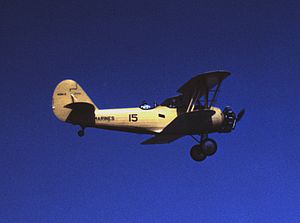Loading AI tools
From Wikipedia, the free encyclopedia
The Naval Aircraft Factory N3N is an American tandem-seat, open cockpit, primary training biplane aircraft built by the Naval Aircraft Factory (NAF) in Philadelphia, Pennsylvania, during the 1930s and early 1940s.
| N3N | |
|---|---|
 US Marine Corps N3N-3 over Parris Island, 1942 | |
| General information | |
| Type | Training aircraft |
| National origin | United States |
| Manufacturer | Naval Aircraft Factory |
| Primary user | United States Navy |
| Number built | 997 |
| History | |
| Manufactured | 1935-1942 |
| Introduction date | 1936 |
| First flight | August 1935[1] |
| Retired | 1961 |
Built to replace the Consolidated NY-2 and NY-3, the N3N was successfully tested as both a conventional airplane and a seaplane.[1] The seaplane used a single large float under the fuselage and two smaller floats under the outer tips of the lower wings. The conventional airplane used a fixed landing gear. The prototype XN3N-1 was powered by a Wright J-5 radial engine. An order for 179 production aircraft was received.[1] Near the end of the first production run the engine was replaced with the Wright R-760-2 Whirlwind radial. The aircraft is constructed using Alcoa's extruded aluminum, with bolts and rivets, rather than the more common welded steel tubing fuselages. Early production models used aluminum stringers formed for cancelled airship construction orders.[2][3][4][5]

The N.A.F. built 997 N3N aircraft beginning in 1935. They included 179 N3N-1s and 816 N3N-3s, plus their prototypes. Production ended in 1942, but the type remained in use through the rest of World War II. The N3N was the last biplane in US military service - the last (used by the U.S. Naval Academy for aviation familiarization) were retired in 1959. The N3N was also unique in that it was an aircraft designed and manufactured by an aviation firm wholly owned and operated by the U.S. government (the Navy, in this case) as opposed to private industry. For this purpose, the U.S. Navy bought the rights and the tooling for the Wright R-760 series engine and produced their own engines. These Navy-built engines were installed on Navy-built airframes.[3]
According to Trimble, "The N3N-3, sometimes known as the Yellow Bird for its distinctive, high-visibility paint scheme, or less kindly, Yellow Peril for the jeopardy in which student aviators often found themselves, showed itself to be rugged, reliable, and generally forgiving to student pilots."[3]
Four N3N-3s were delivered to the United States Coast Guard in 1941.
Postwar, many surviving aircraft were sold on the US civil aircraft market and bought for operation by agricultural aerial spraying firms and private pilot owners. According to Robinet, "The front cockpit had been replaced with a huge metal hopper that loaded from the top and discharged dust from the bottom through a simple venturi type spreader. The airplane was originally powered by a 235 h.p. Wright Radial engine but for their purposes, these were replaced by 450 h.p. Pratt & Whitney radial engines. The engine, wheels and instruments were obtained from the Army BT-13 which was purchased for less that $350.00 each."[6]
A number are still (as of 2014) active in the USA.





Data from Holmes, 2005. p. 96.
General characteristics
Performance
Communications were done by the instructor through a speaking tube to the student in the front cockpit. Communications back were agreed-upon gestures.[25]
Aircraft of comparable role, configuration, and era
Seamless Wikipedia browsing. On steroids.
Every time you click a link to Wikipedia, Wiktionary or Wikiquote in your browser's search results, it will show the modern Wikiwand interface.
Wikiwand extension is a five stars, simple, with minimum permission required to keep your browsing private, safe and transparent.